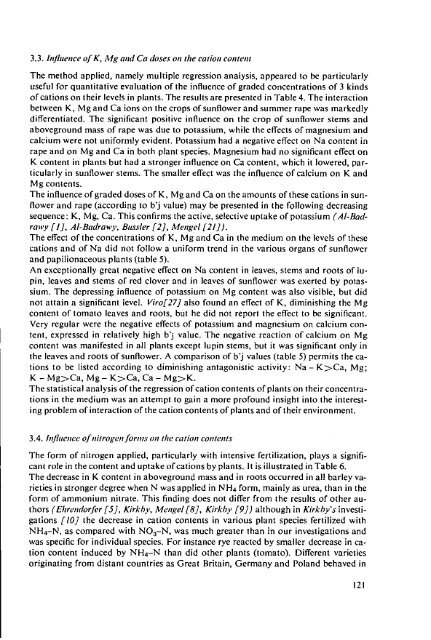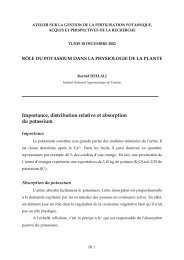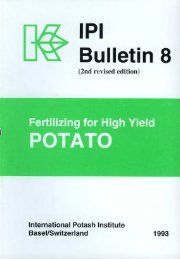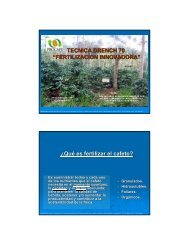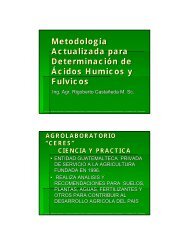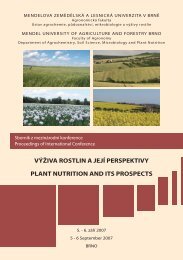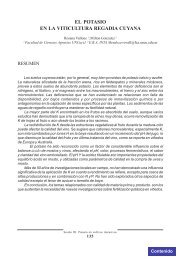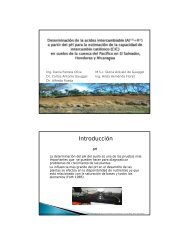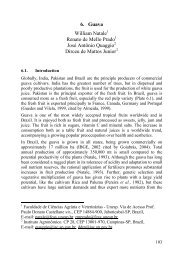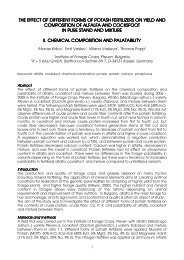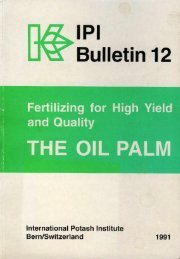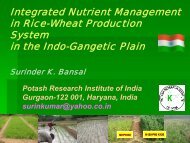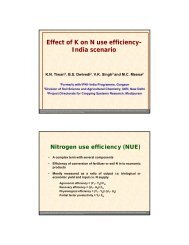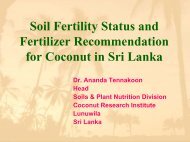Potassium Research and Agricultural Production - The International ...
Potassium Research and Agricultural Production - The International ...
Potassium Research and Agricultural Production - The International ...
You also want an ePaper? Increase the reach of your titles
YUMPU automatically turns print PDFs into web optimized ePapers that Google loves.
3.3. Influence 0/ K, Alg alld Ca doses all the cation contel11<br />
<strong>The</strong> method applied, namely multiple regression analysis, appeared to be particularly<br />
useful for Quantitative evaluation of the influence of graded concentrations of 3 kinds<br />
of cations on their levels in plants. <strong>The</strong> results are presented in Table 4. <strong>The</strong> interaction<br />
between K, Mg <strong>and</strong> Ca ions on the crops of sunflower <strong>and</strong> summer rape was markedly<br />
differentiated. <strong>The</strong> significant positive influence on the crop of sunflower sterns <strong>and</strong><br />
aboveground mass of rape was due to potassium, while the effects of magnesium <strong>and</strong><br />
calcium were not uniformly evident. <strong>Potassium</strong> had a negative effect on Na content in<br />
rape <strong>and</strong> on Mg <strong>and</strong> Ca in both plant species. Magnesium had no significant effect on<br />
K content in plants but had a stronger influence on Ca content, which it lowered, particularly<br />
in sunflower stems. <strong>The</strong> smaller effect was the influence of calcium on K <strong>and</strong><br />
Mg contents.<br />
<strong>The</strong> influence of graded doses of K, Mg <strong>and</strong> Ca on the amounts of these cations in sunflower<br />
<strong>and</strong> rape (according to b'j value) may be presented in the following decreasing<br />
sequence: K, Mg, Ca. This confirms the active, selective uptake of potassium (AI-Badrawy<br />
[I), AI-Hac/raw)', Hllssler [2}. Mellgel [21}).<br />
<strong>The</strong> effect of the concentrations of K, Mg <strong>and</strong> Ca in the medium on the levels of these<br />
cations <strong>and</strong> of Na did not follow a uniform trend in the various organs of sunflower<br />
<strong>and</strong> papilionaceous plants (table 5).<br />
An exceptionally great negative effect on Na content in leaves, stems <strong>and</strong> roots of lupin,<br />
leaves <strong>and</strong> stems of red clover <strong>and</strong> in leaves of sunflower was exerted by potassium.<br />
<strong>The</strong> depressing influence of potassium on Mg content was also visible, but did<br />
not attain a significant level. Viro[27J also found an effect of K, diminishing the Mg<br />
content of tomato lea ves <strong>and</strong> roots, but he did not report the effect to be significant.<br />
Very regular were the negative effects of potassium <strong>and</strong> magnesium on calcium content,<br />
expressed in relatively high b'j value. <strong>The</strong> negative reaction of calcium on Mg<br />
content was manifested in all plants except lupin stems, but it was significant only in<br />
the leaves <strong>and</strong> roots of sunflower. A comparison of b'j values (table 5) permits the cations<br />
to be listed according to diminishing antagonistic activity: Na - K>Ca, Mg;<br />
K - Mg>Ca. Mg - K>Ca. Ca - Mg>K.<br />
<strong>The</strong> statistical analysis of the regression of cation contents of plants on their concentrations<br />
in the medium was an attempt to gain a more profound insight into the interesting<br />
problem of interaction of the cation contents of plants <strong>and</strong> of their environment.<br />
3.4. Influence 0/ nitrogen/arms 011 the cation COlltellts<br />
<strong>The</strong> form of nitrogen applied, particularly with intensive fertilization, plays a significant<br />
role in the content <strong>and</strong> uptake of cations by plants. 11 is illustrated in Table 6.<br />
<strong>The</strong> decrease in K content in aboveground mass <strong>and</strong> in roots occurred in all barley varieties<br />
in stronger degree when N was applied in NH4 form, mainly as urea, than in the<br />
form of ammonium nitrate. This finding does not differ from the results of other authors<br />
(EhrelldorJer [5). Kirkh),. Mellgel [8}. Kirkh)' [9}) although in Kirkhy's investigations<br />
[IOJ the decrease in cation contents in various plant species fertilized with<br />
NH4-N, as compared with N0 3 -N, was much greater than in our investigations <strong>and</strong><br />
was specific for individual species. For instance rye reacted by smaller decrease in cation<br />
content induced by NH4-N than did other plants (tomato). Different varieties<br />
originating from distant countries as Great Britain, Germany <strong>and</strong> Pol<strong>and</strong> behaved in<br />
121


